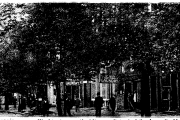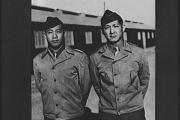The Filipino Women’s Club of Washington D.C.
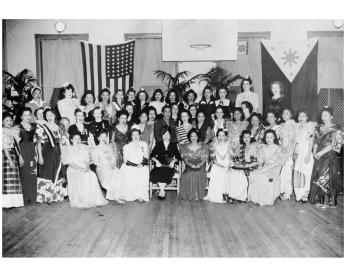
When the U.S. entered WWII in late 1941, women all over Washington stepped up to fulfill wartime needs; and Filipino women were certainly no exception. In fact, many Filipino women had an incredibly personal stake in the wartime conflict.
Within a span of two days, Filipino Americans were forced to grapple with the effects of both the Japanese attack on Pearl Harbor (December 7, 1941) and the Japanese invasion of the Philippines (December 8, 1941). This invasion and later occupation of the Philippines also sparked a new wave of Filipino immigration to the nation’s capital, as President Manuel L. Quezon established a government-in-exile in Washington, D.C.[1] While Filipino-American men enlisted to fight alongside other Americans and organized at The Manila House, women organized a Filipino unit of the American Red Cross. In 1943, this unit evolved into the Filipino Women’s Club of Washington, D.C., an organization that would hold lasting impact in the years to come.[2]
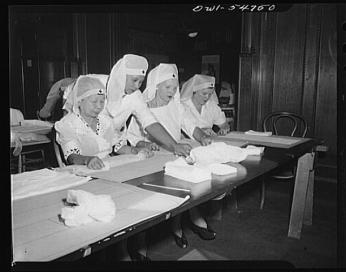
Most of the club’s members were fairly influential and privileged women whose spouses often worked in government (usually the office of the Resident Commissioner of the Philippines or the Philippines’ government-in-exile).[3] Make no mistake, though, these women were also leaders in their own right. Although Sofia De Veyra, for example, is often remembered as being the wife of the former Resident Commissioner of the Philippines, she also worked extensively to help the District community. Indeed, the District of Columbia later awarded her the Red Cross Medal in honor of her eight-hundred hours’ worth of community service.[4] De Veyra, together with Nestora Calabia (President of the club) and Aurora Quezon, helped organize and lead the Filipino Women’s Club of Washington.[5]
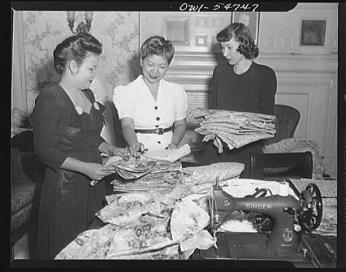
This club was the first of its kind in D.C., but Filipinos and Filipino Americans were already familiar with the idea of women’s clubs. As Sofia De Veyra explained to the white women of the College Women’s Club of Washington D.C., the Philippines had many such clubs of its own.[4] These organizations supplied milk to poor mothers, maintained nurseries, held Christmas celebrations, and even gathered data to support legislation for women and marginalized communities.[4] It was only natural, then, that Filipino women in Washington sought to form a similar kind of service-based club. In The Evening Star’s report on the club’s beginnings, the women remarked that the club’s particular focus, though, was to “give more help to the boys” who were fighting.[2]
Members like De Veyra partnered with the Red Cross and worked on knitting and sewing projects to help hospitals and those in the army.[5] The club also organized benefit events. In June 1944, they presented the Filipino “moving picture, ‘Bituing Marakit’ (Beautiful Star).”[6] The film, “titled from one of the most famous [Filipino] folk songs,” starred an “all Filipino cast” who spoke Tagalog throughout; but the club showed the film with English subtitles to make the event more accessible. The women’s club donated proceeds from the film screening to the affair “for Philippine relief.”[6]
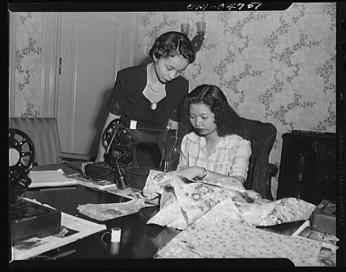
Perhaps the club’s most noteworthy event took place in December 1943, when it hosted a “supper and dance” and invited First Lady Eleanor Roosevelt as an honored “guest speaker.”[7] This dance honored “Filipinos serving in the United States armed forces,” and featured performances by Filipino musicians, an “Abaruray,” or traditional Filipino wine dance, and a singing of the U.S. and Philippine national anthems.[7] The event was memorable enough to warrant a feature in The Evening Star and Roosevelt’s journal. Roosevelt doesn’t give an opinion on the club itself, but she noted:
“Yesterday, I saw quite a number of people in the course of the day. At 6:00 o'clock I went to the USO Club to speak at a buffet supper and dance, which was being given by the Filipino Women's Club in honor of the Filipinos serving in the United States armed forces.”[8]
As the war came to a close, the club continued to foster a sense of community among Washington’s Filipinos. Their annual Christmas party, for example, was “marked by a family gathering atmosphere.”[9] According to The Evening Star, the party provided a place for Filipinos to “rene[w] old friendships” and for children to “pla[y] about, expectantly awaiting the arrival of Santa Claus.”[9] These parties also organized Christmas gifts donations to Filipino children in need.[10]
The club’s influence, however, wasn’t just limited to the Filipino community. There’s evidence that the Filipino women of the club provoked white women to question their initial stereotypes of Filipinos. At one event hosted by the Filipino Women’s Club, De Veyra gave an “eloquent speech” that seemed to surprise the white women in attendance. “Why, I had no idea that Filipino women were refined, cultured, or even educated,” one white woman reportedly exclaimed.[4] According to The Ladies’ Home Journal, this woman voiced “no doubt the sentiment of more than one woman present.”[4] Thus, what began as a wartime service also played a role in shaping the perspectives about Asian-Americans at large.
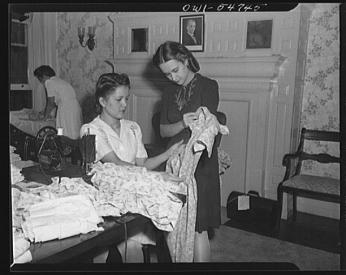
Mention of the Filipino Women’s Club of Washington in local newspapers largely disappears in the years after WWII, but playwright Severino Montana immortalized the women of the club in his play, “The Ladies and the Senator” (1953).[11] Although Montana doesn’t necessarily pay tribute to the club’s service endeavors, his one act satire depicts the women’s club as being instrumental in uncovering a senator’s plunder case.[12] It seems that even after the war, the women of the club didn’t hesitate to voice their opinions about what went on in the city.
Needless to say, the Filipino Women’s Club certainly made its mark on Washington. Although the club isn’t active today, Filipino D.C. historians like Rita M. Cacas make sure to include the Filipino Women’s Club in their histories. As the stories of the club testify, these women are worth remembering, not only for their wartime service, but for the culture and community they inspired when it was most needed.
Footnotes
- ^ Rita M. Cacas and Juanita Tamayo-Lott. Filipinos in Washington D.C., District of Columbia, Arcadia Publishing, 23 November 2009, p. 26
- a, b September 1, 1943, Evening Star (published as THE EVENING STAR.), Washington (DC), District of Columbia, Page 24
- ^ Rita M. Cacas and Juanita Tamayo-Lott. Filipinos in Washington D.C., District of Columbia, Arcadia Publishing, 23 November 2009, p. 68.
- a, b, c, d, e Louisa Knapp, Newell Convers Wyeth, Edward William Bok, “The Ladies' Home Journal, Volume 37,” LHJ Publishing, Incorporated, Feb. 1920, p. 29.
- a, b Rita M. Cacas and Juanita Tamayo-Lott. Filipinos in Washington D.C., District of Columbia, Arcadia Publishing, 23 November 2009, p. 67.
- a, b June 5, 1944 , Evening Star (published as THE EVENING STAR.), Washington (DC), District of Columbia, Page 20
- a, b December 1, 1943, Evening Star (published as THE EVENING STAR.), Washington (DC), District of Columbia, Page 24
- ^ Eleanor Roosevelt, "My Day, December 6, 1943," The Eleanor Roosevelt Papers Digital Edition (2017), accessed 3/12/2020, https://www2.gwu.edu/~erpapers/myday/displaydocedits.cfm?_y=1943&_f=md0….
- a, b December 24, 1945 , Evening Star (published as THE EVENING STAR.), Washington (DC), District of Columbia
- ^ December 15, 1944, Evening Star (published as THE EVENING STAR.), Washington (DC), District of Columbia, Page 23
- ^ Walter Ang, Barangay to Broadway: Filipino American Theater History, Walter Ang, 2018.
- ^ “UP Stages Satirical Comedy Play About Plunder,” ABS-CBN News, https://news.abs-cbn.com/video/lifestyle/v1/02/19/16/up-stages-satirica…, 19 February 2016.




